Allergies on the hands are quite common, and this is explained by the fact that it is the skin of the hands that most often comes into contact with aggressive components. A specific reaction of the immune system to an irritant can manifest itself in different ways - in the form of itching, rash, and redness. It is very important to pay attention to the location of the problem and its nature - such data are extremely important for making a diagnosis and establishing the cause of the condition.
Varieties and causes of allergies on the hands
Allergic manifestations on the hands can appear due to the influence of both external and internal factors. Experts identify several types of problems:
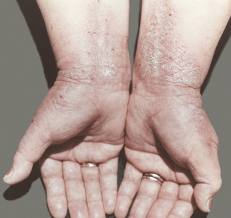 Hand allergies are a common type of immune response to an irritant.
Hand allergies are a common type of immune response to an irritant. Doctor's note: skin changes in the hands may indicate not only allergies, but also various skin diseases. This can be epidermophytosis (fungal disease, manifested by the appearance of a large number of itchy vesicles), eczema (a chronic problem accompanied by swelling and redness of the dermis), scabies (a disease provoked by itching), etc.
The development of an allergic reaction usually occurs with a combination of the influence of an allergen and a factor such as:
- stressful situation, psychological stress;
- weakening of the body, decreased immunity;
- hormonal disruptions and changes in the body;
- heredity.
Symptoms
The manifestations of an allergic reaction depend on what kind of reason provoked them, therefore it is advisable to consider the manifestations based on the factor that prompted them.
Diagnostics
A clear diagnosis can be difficult due to a wide range of other skin diseases that can be localized specifically in the area of the hands. For this reason, if there is a suspicion of the influence of an allergen, specific studies are carried out:
- skin tests. With the help of special tools, shallow, bloodless injuries are made in the forearm. A drop of the alleged allergen is applied to the skin, in the presence of an appropriate reaction, a diagnosis is established - an allergy;
- blood test for the study of antibodies.
Treatment Methods
The first action that should be taken when an allergy appears on the hands is to limit skin contact with the allergen or remove it from the body during a food-type reaction (for this situation, enterosorbents are used, for example, Smecta or Polysorb). Treatment should be prescribed by a doctor, taking into account the type of reaction and all the features of its course.
Medical therapy may include:
- antihistamines for internal (Suprastin, Claritin, etc.) and external use (Psilo-balm). They are relevant if the affected areas on the hands itch;
- agents for suppressing the immune response (calcium gluconate);
- corticosteroids for topical use - they relieve inflammation and itching (Ftorocort, Triderm);
- cosmetic creams and ointments to soften the skin and protect it from negative external influences. Especially relevant for chronic allergic dermatitis;
- if the affected area has been combed, and wounds have formed on it, then it becomes advisable to prescribe antibiotics to prevent infection.
Medications in the photo
ethnoscience
Alternative methods cannot have a serious impact on the mechanism of an allergic reaction and fully treat this condition, however, they can be very useful in reducing manifestations and minimizing discomfort. For skin types of an allergic reaction, you can use the following recipes:
- tubs from a series. 50 grams of herbs are steamed with a glass of boiling water and filtered after cooling. The resulting broth is poured into clean water and hands are placed there for 10 minutes;
- birch tar and petroleum jelly are mixed in equal proportions and applied to the damaged area daily with a thin layer;
- the cabbage leaf is beaten to softness and applied to the affected area for a day, after which the leaf is changed.
Features of the disease in children
In childhood, hand allergies are most often of food origin, the most common allergens of this type are citrus fruits, sugar and chocolate. A favorite place for such a rash is the area of \u200b\u200bthe elbow joints.
When prescribing treatment, all drugs are selected in such a way so as not to harm the growing body. Corticosteroids are usually avoided as they are hormonal agents. Particular emphasis is placed on the effective elimination of itching, since it is difficult for children to control themselves with painful urges to scratch.
Prevention
Preventive measures are to limit yourself from harmful factors that contribute to the development of an allergic reaction on the hands:
- when going out into the cold, be sure to wear gloves, do not wash dishes in very cold water;
- apply protective hand creams;
- when using household chemicals, rubber gloves must be worn;
- if there is a predisposition to allergies, then it is better to limit the amount of highly allergenic foods (citruses, chocolate, seafood) in your diet;
- increase the level of your immunity - play sports, temper, eat right.
treatment-symptomy.ru
Symptoms of occurrence
The manifestations of this disease can be expressed slightly. Slight redness, itching appear and quickly pass on contact with cold air.
However, more serious manifestations are not excluded. Dermatitis rashes begin to peel off, blisters, bruises appear. Pressure indicators are growing, there is increased fatigue, pain in the joints. There is a runny nose and conjunctivitis, a feeling of getting sand in the eyes.
Causes
The causes of manifestation are not fully understood. Symptoms appear suddenly not only in winter. Being in cool water in summer, even chilled desserts on a hot day, can cause a cold reaction.
There are cases of symptoms after illness and long-term use of medicines, against the background of the course of infectious diseases, for example, tuberculosis, mumps, rubella. There are frequent cases of occurrence after inflammation of the upper respiratory tract or due to acquired other allergic reactions.
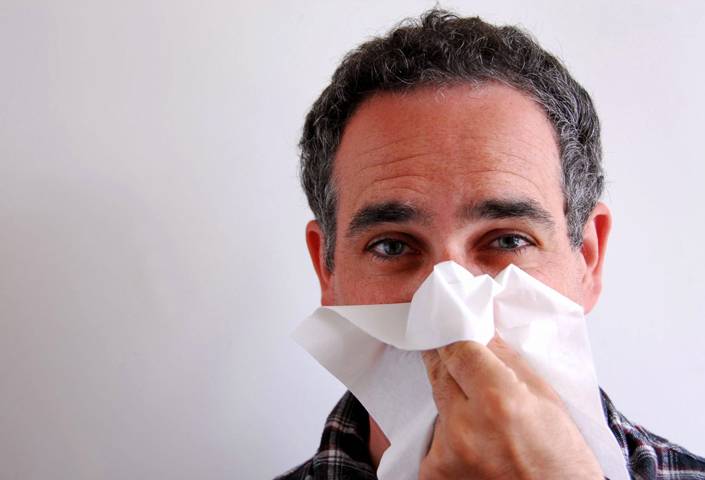
Experts suggest hereditary factor the occurrence of allergies. With a genetic direction, the disease is expressed in a burning sensation on the skin.
A strong immune system fights the disease on its own, temperature changes do not cause any responses in the body. But with even a slight decrease in immunity, a negative response may occur.
Sometimes the trigger for a reaction is stress. Stress-resistant people rarely get sick.
It can also be noted as significant culprits - thyroid disease, oncology, skin diseases, such as psoriasis, eczema.
Allergens
Cold is an allergen for this ailment. It is not possible to eliminate the allergen, except to change the climatic zone of residence. Secondary motives are various reactions, for example, to flowering and medicines.
Manifestations on the hands
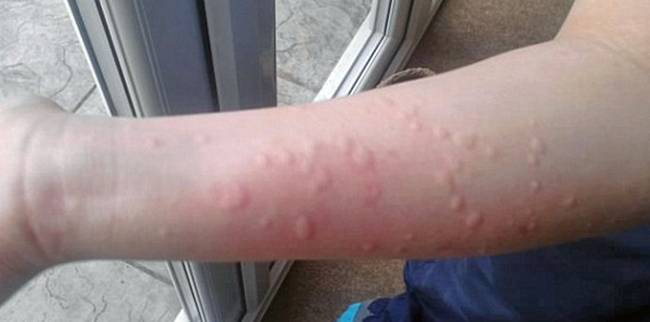
In the event of a reaction on the hands, regular use will be a preventive measure to prevent oily cosmetics. Hands must be protected with warm gloves made of natural compounds.
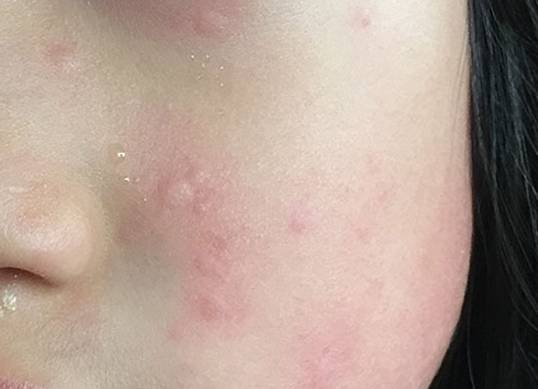
As a preventive measure, it is necessary to treat the skin of the face special protective creams. It takes some time for them to fully absorb. It is desirable that the lipstick contains lanolin, which contains wax of animal origin, which has a softening and protective effect.
An indispensable accessory in the autumn-winter period is a headdress and a scarf.
Manifestation on the legs
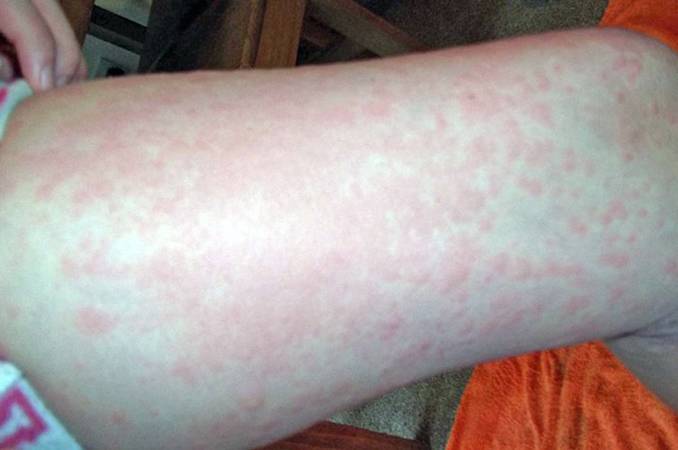
It is necessary to take care of shoes appropriate for the cool season to prevent reactions on the surfaces of the feet. For preventive purposes, a fat cream should be applied to the feet and shins. It is recommended to wear cotton socks, and in case of severe frosts, you can also wear a woolen pair.
For treatment, the use of a hormonal or non-hormonal cream is suitable.
How to treat?
If the diagnosis is confirmed, treatment is carried out in two directions - symptomatic and prophylactic. Antihistamines and hormonal or non-hormonal ointments will help reduce the symptoms of allergies.
For prevention, you can use traditional medicine recipes.
- Fresh beetroot juice in a volume of 100 ml before meals will strengthen the body and cleanse toxins.
- In the cool period of the year, fresh celery juice has a good effect for prevention. Daily use of 0.5 teaspoon will allow you to forget about the ailments associated with the cold.
- As a protective agent, it is good to use badger fat. It is rich in vitamins, acids and trace elements. It is necessary to rub with ointment all affected areas of the body. Ingestion with milk in the morning on an empty stomach an hour before meals will help cleanse and strengthen the immune system. Its use should be limited in cases of liver disease.
- Herbal decoctions also show good results. Burdock root, tricolor violet and walnut leaves, brewed with water in equal proportions, you need to take 60 milliliters 3 times a day. Such a decoction will cleanse the body of the harmful effects of allergens.
- You can take advantage of the beneficial properties of pine cones. Only 4 pieces, ground into powder and brewed in a water bath, will perfectly relieve itching from the affected skin.
For general strengthening of the body, constant hardening should be carried out. A contrast shower and rubdown will help to achieve visible results.
Features of the manifestation of allergy to cold in children
Recently, cold reaction is often observed in children. The changed way of life became the reason for this. Most of the time they are at home. On the street are less and less. Sports have replaced computer games.
When walking in the fresh cool air, redness of the nose and cheeks occurs, itching may occur. Upon returning to the room, rashes resembling hives may appear. Symptoms sometimes disappear on their own without additional treatment. In some cases, a nocturnal cough is possible, accompanied by fever, conjunctivitis and rhinitis.
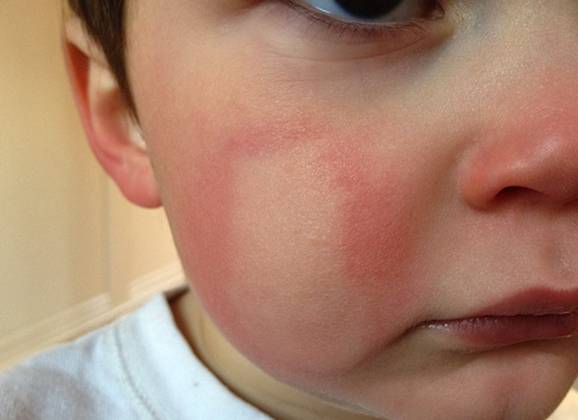
In the home first aid kit there should be antihistamine dosage forms, for example, suprastin or tavegil, to quickly relieve allergic manifestations. Before going outside, you should treat the skin with baby cream. To protect the lips, it is good to use hygienic lipstick.
The best protection from the wind will be a modern accessory hat-helmet. Mittens should be made of waterproof materials with a cotton backing.
A health worker will accurately determine the presence of an allergy to cold in a child and give the necessary recommendations for treatment.
Diagnostics and prevention
You can check for allergies by passing a certain test with a piece of ice. Ice is placed on the back of the hand for 5-10 minutes. If after a while itching appeared, this confirms the presence of this disease. Before starting treatment, it is necessary to check the body to exclude diseases of the gastrointestinal tract and upper respiratory tract.
In preventive measures to prevent the disease, you need to dress according to the weather, underwear should contain natural compounds with good thermal conductivity. Mandatory attributes in the cool season should be gloves, a hat and a scarf. It is necessary to apply a nourishing, oily cream on the skin, lubricate the lips with a hygienic agent. It would be nice to brew hot tea from herbal infusion of yarrow or chamomile.
In the diet, you should refrain from fried foods during the period of exacerbation, the diet should contain fruits and raw vegetables. Instead of meat, it is better to give priority to fish dishes. Sea fish is especially useful. As a side dish, it is useful to use all kinds of cereals. It is desirable to exclude flour products, chocolate products and citrus fruits during the treatment period.
allergiyas.ru
Allergy dermatitis
Allergy-dermatitis: a skin disease of allergic origin is one of the most frequent manifestations of individual hypersensitivity of the skin or the whole organism. In such cases, the action of the allergen, as a rule, is manifested by one of the 4 main symptoms:
- skin rash
- redness
- blisters on the skin (as after a nettle burn)
- severe itching.
In most cases of allergic dermatitis, there is a combination of 2 or more symptoms at the same time (for example, blistering rashes in atopic dermatitis, which are bright red and cause unbearable itching).
Contact dermatitis, the manifestations of which usually have a limited area on the hands, face and some other parts of the body, can have a different origin. Currently, it is customary to distinguish 3 types of contact dermatitis, of which only 2 are related to allergies:
- simple contact dermatitis
- allergic contact dermatitis
- phototoxic contact dermatitis
Simple contact dermatitis is a local reaction of the skin when it is exposed to chemical compounds that have an irritating effect. In most cases, these are widely used household chemicals - especially those designed to clean tiles, bathtubs, sinks, washbasins and the like and remove salt deposits and rust. In this case, the caustic components of detergents and cleaning products damage the top layer of the skin, but do not cause an immune system reaction.
Phototoxic contact dermatitis can be associated with both a local irritant effect on the skin and an allergic reaction. In this case, an allergy is caused by a change in the properties of the photosensitizer under the influence of ultraviolet rays. Photosensitizers are usually substances of plant origin, both accidentally on the skin from the outside (exogenous photosensitizers), and those that enter the body through the mouth and gastrointestinal tract (endogenous photosensitizers). In the latter case, such substances penetrate into the capillaries of the skin with blood and, under the influence of sunlight (or the light of lamps in tanning salons), cause an immune system reaction with the development of allergies. Some drugs can also act as photosensitizers.
And an example of allergic contact dermatitis is nickel allergy, which is very common, where some people get a local allergic reaction from contact with a nickel-plated watch band, metal button, or rivet. Metal allergens include chromium, cobalt, and manganese.
Much more dangerous than allergic contact dermatitis is toxidermia, an acute inflammatory skin disease of a systemic nature. The cause of toxidermia are substances that can cause an allergic reaction in the tissues of the skin, which enter the body either orally with food or drugs, or through the respiratory system.
Regardless of the method of introduction into the body, such substances enter the bloodstream and with it through the capillary vessels penetrate the skin tissues, causing an allergic reaction with damage to the extensive surface of the skin.
Allergy on elbows
Allergy on the elbows in some cases is nothing more than psoriatic plaques - manifestations of psoriasis, which, despite the great similarity of its symptoms with skin lesions in allergies, does not belong to diseases of an allergic nature.
With psoriasis, the affected areas appear on the skin, which are flaky and itchy. The "favorite" place for such plaques is the skin in the area of the knees, elbows and scalp.
People who are far from medicine often refer to plaque rashes on the skin on the outer extensor surface of the elbows and knees as "eczema". However, this is not true - eczema rashes in most cases are localized on the flexor surface, and plaques of psoriasis in such places appear very rarely.
However, there are some forms of eczema (for example, dyshidrotic and pruriginous), in which rashes in the form of small itchy vesicles can be localized just on the skin in the area of the elbow joints. In this case, the development of the disease is dominated by an allergic component.
Differential diagnosis between psoriasis and eczema can only be done by a dermatologist. Self-treatment of both the first and second skin diseases is unacceptable, since in the event of an error in the diagnosis, it can lead to a significant deterioration.
Allergy on hands and feet
Allergy on the hands and feet is usually a symptom of an acute form of urticaria, a rapidly developing allergic reaction, in which blisters of a dense consistency with a pale pink color can appear on different parts of the body.
The appearance of such blisters is accompanied by severe itching.
Reasons for the development of urticaria:
- increased sensitivity of the body to certain foods (eggs, milk, seafood)
- response of the immune system to the drug
- reaction of the immune system to the vaccine during immunization against infectious diseases.
In such cases, the immune system reacts to the appearance of the allergen by the formation of many antigen-antibody immunocomplexes.
In chronic urticaria, rashes on the arms, legs, and torso may not go away for many weeks to months. In this case, an examination by a doctor often saves the patient's life, because sometimes itchy blisters are the first and only symptom of malignant tumors of the large intestine, liver and ovary, as well as blood cancers - myeloma and leukemia.
In milder cases, urticaria often serves as a signal of the appearance of worms in the intestines or of chronic liver disease.
Itchy rashes on the hands and feet can also be observed in various forms of eczema (mycotic or fungal, and especially weeping eczema), which will require long-term treatment.
Allergy on fingers
Allergy on the fingers is a symptom of dyshidrotic eczema, which has another name - pompholyx.
This form of eczema is one of the most common: it is believed that up to 10% of all cases of skin diseases are patients with dyshidrotic eczema.
Pompholyx is characterized by the appearance on the skin of very small (up to 5 mm in diameter) vesicles filled with fluid, called vesicles.
With dyshidrotic eczema, vesicles are first localized on the lateral surface of the fingers, then rashes, accompanied by severe itching, can also appear on the palms, as well as on the soles of the feet.
On the delicate skin of the lateral surfaces of the fingers, a short time after the appearance of the bubbles burst and in their place there are wounds that do not heal for a long time. Erosion wounds can merge, which leads to the appearance of cracks in the skin, in which microorganisms multiply. As a result, the cracks become wider and deeper and cause pain due to the process of suppuration developing in them.
Without treatment, dyshidrotic eczema quickly becomes chronic. Vesicles sometimes disappear, then reappear, and not only in those areas of the skin where they were localized earlier, but also in new ones.
Allergy on hands than to treat
Allergy on the hands - how to treat, is determined by the type of allergic reaction that caused skin damage.
If the skin lesions on the hands are hives that developed after eating a “risk” food or taking a medication (for example, a penicillin antibiotic), then in most cases it will be enough to exclude food with allergenic properties from the diet (citrus fruits, grapes, seafood) or stop the drug. Excellent results will also provide a short (for 2-3 days) intake of antihistamines (suprastin, tavegil and others).
You can quickly get rid of "allergy to the sun" (photoallergic dermatitis), which, under the influence of sunlight, sometimes appears on the skin of the hands in those places where a photosensitizer accidentally appeared (the juice of such common plants as hogweed, angelica and even ordinary parsley) .
If the doctor determines that the patient has one of the many varieties of eczema, the treatment will be complex and longer. It includes:
- taking antihistamines, sedatives, and desensitization drugs
- local treatment with lotions and ointments with corticosteroid hormones
- adherence to a special sparing diet
- treatment of diseases of the internal organs that caused the development of eczema (liver disease, gastrointestinal tract).
An important place in the treatment of allergic rashes on the hands is given to the normalization of the nervous system - stress can provoke both the first appearance of the disease and its relapses. For this, the patient is prescribed sedatives of plant origin (motherwort, valerian root) or drugs from the appropriate groups (benzodiazepines, anxiolytics).
Such patients are also shown the appointment of vitamins A, C and group B.
The skin of the hands is exposed to the maximum impact of adverse external factors (changes in air temperature, wind, moisture, sun). For this reason, both during the treatment of allergies on the hands, and after its completion, the patient must carefully observe preventive measures: wear gloves in winter, and in summer, if necessary, apply moisturizing creams to the skin of the hands.
www.health-ua.org
Rash on arms and legs
Contrary to popular belief, a rash does not appear only on the background of malnutrition. It may be preceded by hundreds of causes, so do not self-medicate. Similar problems do not bypass both newborn babies and the older generation. Only with an adult baby it is much easier: he is able to describe the accompanying symptoms, and the main sources of its occurrence are most often known to parents.
An allergic rash on the hands and feet of a child can indicate many diseases. Depending on the similarity of signs, they are divided into three types:
Allergic manifestations;
pathology of the blood and blood vessels;
lack of proper hygiene.
Each species has its own characteristic symptoms. In addition to damage to the skin, there may be discomfort in the throat and abdomen, high fever, runny nose, cough, loss of appetite, trembling in the body and other reactions. Almost the same courses of treatment are inherent in all three types, but only a specialist should prescribe drugs.
On hands
An allergic rash on the arms and legs of a child is the reason for the most frequent visits by mothers and fathers for medical advice. Among the main reasons for its occurrence are the following:
- An allergic rash on the hands in some cases may be a reaction that is hereditary. It is distinguished by characteristic bubbles on the skin that are filled with liquid (see photo). Such manifestations are called atopic dermatitis.
- Allergic (contact) dermatitis. This type is characterized by irritation of those areas whose skin was in direct contact with the irritant. These can be children's cosmetics, poor-quality fabrics from which clothes are sewn, new synthetic detergents, or old ones that have not been rinsed out well during washing. This allergic rash on the arms and legs of the baby occurs some time after contact. It may take up to several days from the last interaction for her to disappear. In rare cases, rashes appear due to allergens (pollen, wool, dust) that have entered the body.
- With a bacterial infection, the skin is affected by streptococci. In the photo you can clearly see how large red sores with bubbles poured out. Similar manifestations can occur on the face and limbs at the time or after the end of an infectious disease.
- Fungal etiology (rubromycosis) is mainly observed on the skin of the hands. The most suitable time for its appearance is the period of weakening of the immune system. It is characterized by itchy sensations and increased dryness between the fingers.
On foot
All of the above moments of the formation of an allergic rash can occur both on the arms and legs of the child. It should be added that the eruptions, which many ignorantly call urticaria, may appear due to prickly heat, which newborns often suffer in the summer.
Red dots on legs, accompanied by painful sensations and severe itching, may be a reaction to the bites of bedbugs, horseflies or mosquitoes.
Vesilocupustulosis, i.e. staphylococcus, accompanied by a rash with small ulcers. Formed on the arms, legs, neck, head, back, chest and causes severe itching.
Manifestations of scarlet fever- dense rashes on the legs, arms, and all over the body. A runny nose with a cough and high fever, followed by a rash, is already evidence of measles.
Symptoms and treatment
Urticaria on the hands has characteristic symptoms, and it should be treated by a doctor. At the first sign of an allergic rash in your child, you should:
Call a specialist at home;
suspecting a child is infected with meningococcus, an ambulance should immediately call an ambulance;
do not rush to self-medicate before the arrival of the doctor, this also applies to cauterization with brilliant green.
What to do if a child has a rash on his arms and legs without fever?
Most often, a small rash on the arms and legs of a child without fever can be the cause of prickly heat, allergies, or neurodermatitis. The most harmless is prickly heat, with proper hygiene, it quickly disappears, it does not need to be treated. If your child is allergic, then a harmless insect bite can cause blisters, sometimes even Quincke's edema. With neurodermatitis, a reaction with very strong itching is observed, a runny nose is possible, accompanied by bronchial asthma. Therefore, in order to exclude further negative consequences, it is better to immediately seek qualified help, and not guess how to stop the symptoms.
The child has a rash and fever
When a child has rashes on the arms and legs after insect bites, they can be treated with Fenistil-gel or Psilobalm. The drugs will quickly relieve allergic itching. If there is a temperature, give the baby an antipyretic and any antihistamine.
Any infectious diseases accompanied by a rash and high fever, which we discussed above, require urgent medical intervention and, if necessary, the placement of the child in a hospital.
Treatment of an allergic rash with folk remedies
It will not always be right to use folk remedies as the main treatment, even if the child has a rash only on the arms and legs. For example, allergic children may have hypersensitivity or individual intolerance to a particular herbal component.
Of the safest, we can advise infusions of chamomile, succession and oak bark. You can treat allergic rashes using herbal baths and creams. This method is also suitable for adults.
Preparing the infusion is very simple: you need to brew in 200 ml. boiling water three tablespoons of herbs, then let the broth brew. Such baths are best done no more than 3 times a week.
Hives
Urticaria is a very common disease. Its symptoms are similar to nettle burns, and it also resembles insect bites in appearance. By eliminating the allergen, after a while the blisters on the skin disappear on their own. Urticaria should be treated by identifying and removing the allergenic substance that provokes it.
In the acute form, laxatives, antihistamines and hyposensitizing drugs can help. For severe cases, corticosteroids and adrenaline are used.
In addition to the above, urticaria on the arms and legs involves treatment with antipruritic agents. These include salicylic acid, calendula solution, menthol alcohol solution (1%).
Do not forget that it is recommended to treat urticaria in children only after examination by a specialist. It is he who must identify the cause and prescribe a course of medication. Folk remedies are recommended only for prevention.
fitohome.ru
 Allergy on the hands is a very common phenomenon in recent years, which is usually accompanied by such allergic manifestations as hives, redness and a rash with severe itching. Allergy on the skin of the hands is caused by the influence of various not always favorable environmental factors, which include household chemicals, detergents, cold, wind, water containing a large amount of harmful impurities, etc. When any allergen enters the body, the immune defense reacts with the instant production of appropriate antibodies . One of the main signs of this process is an allergy that has appeared on the hands.
Allergy on the hands is a very common phenomenon in recent years, which is usually accompanied by such allergic manifestations as hives, redness and a rash with severe itching. Allergy on the skin of the hands is caused by the influence of various not always favorable environmental factors, which include household chemicals, detergents, cold, wind, water containing a large amount of harmful impurities, etc. When any allergen enters the body, the immune defense reacts with the instant production of appropriate antibodies . One of the main signs of this process is an allergy that has appeared on the hands.
Human hands are in constant contact with the environment, as a result of which they are exposed to adverse effects almost continuously. In the case of prolonged exposure to the skin of the hands of any harmful element, rashes appear called allergic dermatitis, which is different in nature. High or low temperatures, mechanical or chemical factors, electric current, etc. can serve as a catalyst for the development of this allergic reaction. Allergy on the hands of a child usually develops if the allergen enters the body again, since after the initial contact, the immune defense mechanism begins to produce antibodies , which begin to act actively after the second invasion of the allergen.
Today, a large number of people (more often women) suffer from strong chemical compounds in detergents, which manifests itself as an allergy to the fingers. As a result, when using any modern detergents, it is imperative to wear gloves that are able to completely protect the skin from exposure to aggressive chemicals.
Hand allergies - symptoms
In addition to rashes, hand allergies have the following accompanying symptoms: swelling, swelling, severe itching, watery blisters. In some cases, the fingers are almost impossible to bend, and if this is possible, then the person experiences very strong pain.
Allergies on the arms and legs in children usually occur in the elbow and knee joints and develop as a result of overeating sweets. In some people, these manifestations are a reaction to low temperatures, which is manifested by painful redness of the skin, which becomes dry, thin and vulnerable.
Dermatitis can be chronic or acute. In chronic dermatitis, peeling and thickening (pichenization) are observed at the sites of skin lesions. Acute dermatitis is characterized by swelling and redness of the skin. As time passes, bubbles filled with transparent contents appear at the site of irritation, which, if the adverse factor continues to act, begin to burst, which often leads to the development of a bacterial infection. After healing of such wounds, scars and scars often remain at the site of irritation.
If the skin on the hands began to dry and there was a suspicion of an allergy on the hands, it is not worth rushing to make a diagnosis of allergic dermatitis on your own, as this may be the usual immunity of a certain component of household chemicals, after stopping contact with which all allergic manifestations go away on their own.
If, after being in cold water, the skin on the hands becomes thin, sensitive, painful, an itchy rash appears on it and it becomes bright red, this may be an allergy to the cold on the hands.
Allergy on the hands - treatment
The hands of a person are always open to the gaze of others and therefore the presence of any changes on them requires immediate action. If there are no pathological bases under dry skin, moisturizers in the form of gels and creams can effectively soften it and remove the corresponding manifestations. However, if changes in the skin occur under the influence of any allergen, moisturizing will not bring absolutely any positive effect. Most often, hand allergies develop in young children. Children usually outgrow their allergies as they get older.
Before you choose the most effective ointment for allergies on your hands, you should be completely safe from meeting with a provoking allergen. The most adequate effective treatment can only be prescribed by a qualified dermatologist.
Local treatment of allergies on the hands consists in applying anti-allergic ointments to the skin, which include drugs on a non-hormonal, hormonal and mixed basis. The drug necessary in each specific case can only be correctly prescribed by a dermatologist, since in response to a seemingly completely harmless ointment, the skin may react completely inadequately.
Hormonal ointments should be used very carefully, since in response to a positive effect in one, side effects may develop in another. The use of ointments is carried out according to a specially designed scheme, when at the beginning a small amount of a hormonal agent is applied to the skin. If after that a positive result is not observed, a stronger ointment is applied to the skin (in a day). After achieving the desired result, a transition to a more gentle drug is carried out.
The simplest prevention of hand allergies is the use of gloves when in contact with various aggressive agents. Also, people prone to this type of allergic reaction should wear gloves with the onset of cold weather. Allergen-prone skin is also sensitive to sunlight, so light gloves should be worn even in summer. The use of protective creams helps quite well, as they form an invisible film on the skin that protects against harmful effects.

